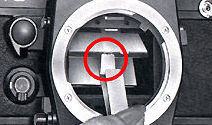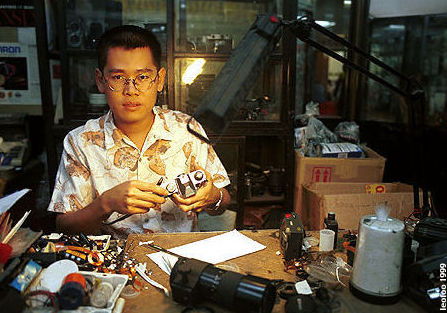Interchangeable Focusing Screens
Often considered a handy feature along with interchangeable prisms (Interchangeable
Finders feature is NOT available with any of the Contax SLR camera models).
Why would anyone wanted to change the focusing screen ? Because not all photographers
are engaging with the same assignment or applications or simply just cannot be sure
of what are they will be using with their cameras. Well although the camera is supplied
with a standard screen but it is hard to use simply a split image rangefinder screen
to handle all form of assignment and conditions. For an example, it is difficult
to use a standard screen type to shoot astrophotography; some photographers who often
use the camera for copying work will find a matte screen with vertical and horizontal
lines more useful than any other screens.
Some of the focusing screen design are quite unique in its class. Take an example
of the FS41 (Split Image/Microprism Collar with data guide mark), it is a split image/microprism
collar type featuring guide marks showing where information from Data Back Quartz
D-4 will be recorded onto the film. As you compose through the viewfinder, you will
be able see whether the recorded data will be placed against a background of the
right contrast. FS.5 (Matte Field) screen is an ideal screen for all round general
photography where you trust your eyes most and does not like the cluttering of the
outline and focusing aid inside the viewfinder. Anyway, as far as focusing screen
is concerned, it is a matter of personal preference. Just select a screen type that
can make you feel more positive and you think that can help you be more responsive
and productive in your work, Errr... may be creative at times.
UPDATE:-
Hello, First, thank you for an amazing site! I feel that your page on Contax focusing
screens could be improved a bit. Are you aware that the RTS II screens do not fit
the original RTS? The screens for the original RTS are a bit smaller and the tab
is located in a different place. Searching the net it's very difficult to find information
on which screens fit the original RTS and based on KEH's pages the correct answer
seems to be screens without a prefix like #1 = microprism or #3 = split-image 45
degree while the numbering is the same as the RTS II FS-series screens. It would
be great if you could add this info to your page and maybe prevent others making
the mistake of getting a RTS II screen for the RTS. A separate row for the RTS in
the quick reference table would be very nice.
Best Regards, Petri Rahikkala <petri_rahikkala@hotmail.com>
 |
|
<Removing the Screen> |
 |
<Installing the Screen> By using the tweezers, grip the lobe on the replacement screen and insert the screen in the descended screen frames. Then reposition the screen frame by gently pressing other end of the tweezers up against a small projection on the frame until it firmly snaps into place. |
* Be sure to use the special tweezers described above when removing or installing the focusing screen, being careful not to scratch or mark the screen and mirror surfaces.** Be sure to install the screen correctly otherwise the screen may become dislodged and damaged, even causing lens removal or installation difficulty. When this occurs, take the camera to your nearest camera shop for professional service.
<Types of Focusing Screens Available>
 |
FS-1 (Microprism) * for general photography. A matte screen surrounding a microprism focusing spot in the center, enabling focusing with both fields. |
 |
FS-2 (Split-lmage) * For general photography. Focus by lining up the images in the diagonal split-image center cut 45 degrees to the horizontal plane. Effective for critical focus of subject with horizontal or perpendicular lines |
 |
FS.3 (Horizontal Split-lmage) * With the split-image center being placed horizontally, makes for quick, critical focusing of subjects with perpendicular or diagonal lines. Also suitable for general photography as in case of diagonal split-image screen. |
 |
FS.4 (Split Image/Microprism Collar) * Suitable for general photography and assures pinpoint focusing via a horizontal Split-lmage focusing spot surrounded by a microprism collar in the center of a matte field, all three areas combining to provide three-way focusing. |
 |
FS.5 (Matte Field) All matte screen for focusing. Ideal for use with comparatively slow lenses of long focal length or for close-up work, making it suitable in situations where focusing difficulties are encountered with microprism or split-image type screens. |
 |
FS.6 (Sectioned Matte) A matte screen with vertical and horizontal lines equally spaced 6 mm apart to facilitate composing of your subject. Effective for perspective control shots with the Auto Bellows PC or the PC-Distagon lens, and for close-up work. |
 |
FS7 (Cross-Scale) Suitable for photomicrography and close-up work. Focus by using clear, bright screen in center. Surrounding matte field can also be used for focusing. With cross hair reticle and scales graduated at 1 mm intervals, it enables you to gauge the magnification ratio or filmed image size of subject. |
 |
FS41 (Split Image/Microprism Collar with data guide mark) * This is a split image/microprism collar type featuring guide marks showing where information from Data Back Quartz D-4 will be recorded onto the film. As you compose through the viewfinder, you will be able see whether the recorded data will be placed against a background of the right contrast. |
* Note: When using a telephoto or other slow lens such as f/4, f/5.6 or slower, or in close-up photography, the microprism collar and split-image may become dark and cause focusing difficulty. In such a case, use the outer matte field for focusing. |
CAMERA CARE and Maintainance... This man will be most delighted to see your SLR breakdown because of carelessness, hehe....
 |
• The normal operating temperature range for the RTS 11 Quartz is between + 50 and - 20 degrees centigrade but exposure to sudden temperature changes should be avoided. When the camera is suddenly brought into a warm room after shooting in cold areas or in wintry hills, there is a danger of condensation forming on the exterior and interior surfaces of the camera. |
On the other hand, when the camera is taken
from a warm room and suddenly exposed to cold outdoor temperatures, its surfaces
can become fogged just as glass windows do on cold days, and can cause freezing of
any condensation inside the camera. In either case, if camera care is neglected it
could lead to corrosion of the camera mechanism. Do not subject your camera to sudden
changes in temperature–be sure to allow the camera to gradually adjust to sudden
temperature changes. It should be noted that in extreme cold weather areas, where
the camera's battery has been temporarily affected by a low temperature, there are
times when optimum camera performance may not be obtain able even though the surrounding
temperature is within the camera's operating range given above.
•
Avoid leaving the camera in the direct sun, glove or luggage compartment, rear seat
shelf of car and other hot spots as it may adversely affect the camera, battery or
camera system and result in improper exposure. If the camera has been exposed to
excessive heat, allow it to cool to normal temperature before use.
•
Take care to keep the camera clean when using it at the seashore, in the mountains
and in the rain. Airborne salt, sand, dirt and other foreign matter will damage the
camera's internal system if allowed to penetrate inside.
•
Avoid touching the lens, viewfinder eyepiece and other glass surfaces with your fingers.
Blow dust and dirt away from these surfaces with a blower brush, or wipe gently with
a soft cloth (after brushing) if necessary. Clean smudges and smears on lens and
mirror surfaces with high quality lens-cleaning solution and tissue. Always take
extra care in cleaning the lens and mirror surfaces to avoid scratching.
•
Always be sure to make a functional check of the camera when going to take those
important shots (wedding, travel, business photos, etc.)
•
It should be noted that when print films are processed, standard service-size prints
will show an area slightly less than that seen on the negatives.
Note on Filter Usage
When certain brands of commercially available filters are used with Zeiss T*
lenses, there is a possibility of cutting off the corners of the image. For this
reason we strongly recommend the use of the Contax brand filter with all Zeiss T*
lenses used on your camera.
| Previous |
Next |
Main Reference
Map | Specification
Beyond the
User's Manual, some
relating topics:
6 Parts
Other Contax Accessories: Filters
| Eye-Cups / Diopter lens
/ Right
Angle Finder / Magnifier| Lens Caps/Lens Rear Caps / Body Caps / Lens Pouches
| Soft lens Shades/Metal Lens Hoods/Adapter Ring/Gelatin Filter
Holder set | Focusing Screens
| Back | to Index Page of Contax
RTS
| Back | to Index Page of Contax
RTS II Quartz
| Back | to Index Page of Contax
RTS III
| Back | to Main Index Page of
Contax RTS series models
Camera
Models: | Contax RTS |
RTS II | RTS
III
|
Shared
Resources:|
Motor
Drive-
PMD
W6| Winder - RTW-W3 | Screens |
Flash | Macro | Remote | Databack | Accessories | Zeiss T* Optic | Instruction Manuals: Contax RTS HTML | PDF | Contax RTS II Quartz
HTML | PDF | Contax RTS III (3
parts PDF
by mike@butkus.org, M. Butkus, NJ. Part A | Part B | Part C |
OFF TOPIC:-
Personal Note
| Main Reference
Map: RTS - HTML | PDF (206k) RTS II - HTML | PDF(308k) RTS III - HTML | PDF |
Specification: RTS - HTML | PDF(159k) RTS II - HTML | PDF(66k) RTS III - HTML | PDF |
1975: RTS 1979: 139Q 1980: 137MD 1982: 137MA 1982: RTS II |
1985: 159MM 1987: 167MT 1990: RTS III 1992: S2 1992: S2b |
1992: ST 1994: RX 1996: AX 1998: Aria 2000~ |
| List of Carl Zeiss T* lenses for Contax SLR cameras | ||||
| Message Board | for your favorite Contax RTS Series SLR Models
| Message Board | for your Contax optics
in a shared environment
| Message Board | Specifically for Dispose or Looking for Contax Photographic
Equipment
About this
photographic
site.
| Home - Photography in Malaysia |
Credit: MClau, joint maintainer of the Contax RTS MB. Some of the content are extracts from: Cees De Groot, who maintains a Contax FAQ site and Tim Roger website on Contax SLR cameras, A few of the images on Zeiss lenses were downloaded from Contax US website. My buddy, Yeak † & Rizal Yahya, for their cool programming with Contax RTS's Message Board, Note:certain contents and images appeared in this site were either scanned from official marketing leaflets, brochures, sales manuals or publications published by Kyocera over the years and/or contributions from surfers who claimed originality of their own work solely for educational purposes. The creator of the site will not be responsible for any discrepancies that may arise from such possible disputes except rectifying them after verification."Kyocera", "Yashica", "Contax" & "Carl Zeiss T*" are registered trade names of Kyocera Corporation Inc., Japan. A site made with an Apple IMac, dedicated to all fans of Contax cameras and Zeiss Optics.
